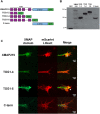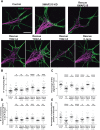XMAP215 promotes microtubule-F-actin interactions to regulate growth cone microtubules during axon guidance in Xenopuslaevis
- PMID: 30890650
- PMCID: PMC6526707
- DOI: 10.1242/jcs.224311
XMAP215 promotes microtubule-F-actin interactions to regulate growth cone microtubules during axon guidance in Xenopuslaevis
Abstract
It has long been established that neuronal growth cone navigation depends on changes in microtubule (MT) and F-actin architecture downstream of guidance cues. However, the mechanisms by which MTs and F-actin are dually coordinated remain a fundamentally unresolved question. Here, we report that the well-characterized MT polymerase, XMAP215 (also known as CKAP5), plays an important role in mediating MT-F-actin interaction within the growth cone. We demonstrate that XMAP215 regulates MT-F-actin alignment through its N-terminal TOG 1-5 domains. Additionally, we show that XMAP215 directly binds to F-actin in vitro and co-localizes with F-actin in the growth cone periphery. We also find that XMAP215 is required for regulation of growth cone morphology and response to the guidance cue, Ephrin A5. Our findings provide the first strong evidence that XMAP215 coordinates MT and F-actin interaction in vivo We suggest a model in which XMAP215 regulates MT extension along F-actin bundles into the growth cone periphery and that these interactions may be important to control cytoskeletal dynamics downstream of guidance cues. This article has an associated First Person interview with the first author of the paper.
Keywords: +TIP; CKAP5; Cytoskeleton; F-actin alignment; Growth cones; Plus-end tracking proteins; Super resolution.
© 2019. Published by The Company of Biologists Ltd.
Conflict of interest statement
Competing interestsThe authors declare no competing or financial interests.
Figures







Similar articles
-
The TOG5 domain of CKAP5 is required to interact with F-actin and promote microtubule advancement in neurons.Mol Biol Cell. 2024 Dec 1;35(12):br24. doi: 10.1091/mbc.E24-05-0202. Epub 2024 Nov 6. Mol Biol Cell. 2024. PMID: 39504455 Free PMC article.
-
Growth cone-specific functions of XMAP215 in restricting microtubule dynamics and promoting axonal outgrowth.Neural Dev. 2013 Dec 1;8:22. doi: 10.1186/1749-8104-8-22. Neural Dev. 2013. PMID: 24289819 Free PMC article.
-
The +TIP Navigator-1 is an actin-microtubule crosslinker that regulates axonal growth cone motility.J Cell Biol. 2020 Sep 7;219(9):e201905199. doi: 10.1083/jcb.201905199. J Cell Biol. 2020. PMID: 32497170 Free PMC article.
-
Cytoskeletal social networking in the growth cone: How +TIPs mediate microtubule-actin cross-linking to drive axon outgrowth and guidance.Cytoskeleton (Hoboken). 2016 Sep;73(9):461-76. doi: 10.1002/cm.21272. Epub 2016 Feb 8. Cytoskeleton (Hoboken). 2016. PMID: 26783725 Free PMC article. Review.
-
Xenopus laevis as a model system to study cytoskeletal dynamics during axon pathfinding.Genesis. 2017 Jan;55(1-2):10.1002/dvg.22994. doi: 10.1002/dvg.22994. Genesis. 2017. PMID: 28095612 Free PMC article. Review.
Cited by
-
TUBA1A tubulinopathy mutants disrupt neuron morphogenesis and override XMAP215/Stu2 regulation of microtubule dynamics.Elife. 2022 May 5;11:e76189. doi: 10.7554/eLife.76189. Elife. 2022. PMID: 35511030 Free PMC article.
-
The TOG5 domain of CKAP5 is required to interact with F-actin and promote microtubule advancement in neurons.Mol Biol Cell. 2024 Dec 1;35(12):br24. doi: 10.1091/mbc.E24-05-0202. Epub 2024 Nov 6. Mol Biol Cell. 2024. PMID: 39504455 Free PMC article.
-
Establishing neuronal polarity: microtubule regulation during neurite initiation.Oxf Open Neurosci. 2022 May 13;1:kvac007. doi: 10.1093/oons/kvac007. eCollection 2022. Oxf Open Neurosci. 2022. PMID: 38596701 Free PMC article. Review.
-
Tourette Syndrome Risk Genes Regulate Mitochondrial Dynamics, Structure, and Function.Front Psychiatry. 2021 Mar 10;11:556803. doi: 10.3389/fpsyt.2020.556803. eCollection 2020. Front Psychiatry. 2021. PMID: 33776808 Free PMC article.
-
Bridging the Gap: The Importance of TUBA1A α-Tubulin in Forming Midline Commissures.Front Cell Dev Biol. 2022 Jan 19;9:789438. doi: 10.3389/fcell.2021.789438. eCollection 2021. Front Cell Dev Biol. 2022. PMID: 35127710 Free PMC article.
References
-
- Alves-Silva J., Sánchez-Soriano N., Beaven R., Klein M., Parkin J., Millard T. H., Bellen H. J., Venken K. J. T., Ballestrem C. and Kammerer R. A. (2012). Spectraplakins promote microtubule-mediated axonal growth by functioning as structural microtubule-associated proteins and EB1-dependent +TIPs (tip interacting proteins). J. Neurosci. 32, 9143-9158. 10.1523/JNEUROSCI.0416-12.2012 - DOI - PMC - PubMed
Publication types
MeSH terms
Substances
Grants and funding
LinkOut - more resources
Full Text Sources
Other Literature Sources

